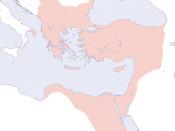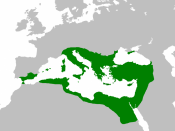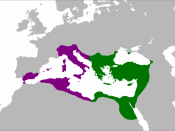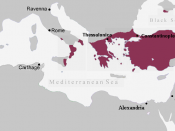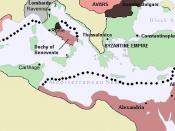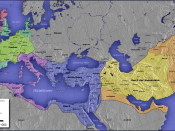After the collapse of the Roman Empire in 476 C.E., much of the Mediterranean basin was in disorder with no leadership. Germanic tribes from the north had conquered the last emperor and claimed the land their own. But in the east, a new empire was blooming, the Byzantine Empire. The Byzantine Empire was both similar and different from the previous Roman Empire, and its greatest ruler, Justinian, made it his main ambition to regain the lost territory, and power of Rome.
The empire of Byzantium was the only classical empire to survive the erratically difficult period of time some 500 years after the turn of the millennium. Problems such as epidemics, diseases, declining populations, economic contraction all contributed to fall of Rome. Political turmoil, social unrest, and outside military threats also ravaged the late Roman Empire, causing its demise. Yet Byzantium managed to hold onto power throughout this time because it controlled many key sea routes coming to and from the eastern Mediterranean Sea.
The Byzantine Empire also had many of its roads and waterways still intact, as well as methods of long distance communication, with a set of authoritative institutions from the preexisting Roman Empire. Byzantium became a prosperous center of commerce. Because of these economic and political strongholds, Byzantium quickly gained recognition as an empire that produced fine manufactured goods including silk and items of interest. This example of economic strength is similar to the type of economy that the earlier Roman Empire relied on. Rome was very well know for its manufactured goods, offering items of great trade value such as glassware, jewelry, bronze items, linen and wool textiles, iron tools, and pottery. Thus, the Byzantine Empire carried on the Roman legacy of heavy dependence on industry and trade (Marston 80, Evans 121, Adkins 254).
Roman standard of law and influence were also carried on by the Byzantines Byzantine ambassadors and representatives traveled east and introduced writing, Christianity, law codes, and political organization to Slavic peoples in Eastern Europe stretching to regions of western Russia. This helped integrate many different cultures into one, thus bringing unification to the area east of the Mediterranean. This way of spreading different concepts to areas neighboring the Byzantine Empire goes hand in hand with the format the Romans used. This influenced touched both the areas of Northern Africa and Western Europe the same way it touched the Roman Empire. The introduction of multicultural interaction with surrounding lands helped result in the advancement of the Byzantine Empire in ways similar to how the Romans rose to power.
Remarkably, the Byzantines built an Empire that was closely similar to the Romans in how they ruled themselves. Both empires had governments that were focused tightly around a strong centralized political system, with an emperor overseeing political, military, judicial, financial, and religious issues. The latter emperor, Constantine of Byzantium, also carried on the Roman tradition of lavish spending, building a new capitol filled with museums, libraries, and artistic treasures. In addition, he constructed glorious marble churches, palaces, public buildings, and baths (Evans 103). These examples of government, as well as cases of how emperors lived, show further similarities between the Byzantine and Roman Empires.
Although there were many similarities between the Byzantine Empire and the Roman Empire, there were also various differences. Perhaps the most prominent difference is established in the way the Byzantines ruled portions of their empire in comparison to the way the Romans ruled portions of their empire. The Byzantines developed political and social adjustments in the face of Islamic conquests (something Romans never had to deal with for a very long time). The arrangement that Byzantine rulers composed was called the theme system. Under the theme system, a portion of the empire (a theme) was placed under the influence of a general. This general took on the role of overseeing his theme's military defense structures as well as its civil administrations. These generals were subject to close supervision by the government, to prevent the possibility of decentralization of power and authority. The generals would recruit armies from free peasants who would then quickly organize to counter any possible attack from invaders. This system greatly strengthened Byzantium's defensive military efforts, and fortified the peasant class, resulting in greater agricultural production (Adkins 302, Evans 98, Catholic Encyclopedia).
A second difference between the Byzantines and the Romans is revealed the way their military systems operated. The Romans often used their military in an offensive manner up until the last few centuries before the collapse of the empire. Rome's vast armies frequently crusaded against surrounding settlements to gain territory and expand their huge realm. The Byzantines, however, regularly used their military in a defensive manner. Surrounding civilizations such as the Sasanid Empire commonly threatened the Byzantines, as did widespread Islamic conquests. Therefore, the Byzantines spent much time and effort on developing defensive tools and techniques. One tool they developed was a variation of a flamethrower that became known as "Greek Fire" (Adkins 222). This weapon used sulphur, lime, and petroleum to literally burn down frontlines of invading enemies. The fire from this weapon also burned on the surface of water. Thus, if an attack was approaching by sea, the Byzantine armies could deploy the use of this weapon, and either halt the precedence of these ships, or, the most frequent effect, simply burn the ship and the men in the water. This weapon gave the Byzantines a distinctive defensive edge, and also helped demonstrate the difference between their battle styles, and those of the Romans.
An interesting difference between the Byzantines and the Romans can be observed in the general cultures of each society. For example, the bureaucrats in Roman government were not particularly showy or flamboyant (with the exception of Julius Creaser). All officials, including the emperor, dressed in simple white robes. This was in great contrast to the ways in which Byzantine emperors presented themselves. In the sixth century C.E., Byzantine emperors became exalted, absolute rulers. Therefore, they were portrayed in a manner that clearly presented their status. The emperors wore a profoundly bejeweled crown, and dressed in elaborate silk robes dyed dark, rich purple. Purple was reserved only for persons associated with the ruling house, as it was a color signifying power. As a result, it was forbidden for anyone else to wear it. Another example of the Byzantine court's sophisticated approach to daily affairs was the way in which even high subjects presented themselves to the emperor. Before saying anything to him, they had to prostrate themselves three times, and then kiss the emperors hands and feet (Marston 74). After this, then they could begin to discuss their business with the imperial ruler. Complex presentations were not reserved for subjects either. By the tenth century C.E. the emperor himself had engineers design devices that created stunning effects and awed foreign visitors. In front of an audience, the imperial throne itself sometimes moved up and down to accentuate the exalted status of the emperor. These cultural examples of imperial presentation and dress further highlight differences between the Byzantine and Roman Empires.
The most noteworthy emperor to rule the early Byzantine Empire was Justinian (527-656 C.E.). Justinian is best recognized for his development of a vital code of laws that came to govern the Byzantine Empire for centuries after his reign. These laws continue to be an important reference to establishments of law today. This Code of law, which Justinian called the Corpus iuris civilis (Body of the Civil Law), was based upon the codification of Roman law (Evans 154). Almost immediately after he became emperor, Justinian ordered a methodical evaluation of Roman law that was more detailed than ever before. Justinian's law code came to influence later emperors, and also served as the basis for many law codes to come in western Europe.
Yet the development of a revised code of law was not Justinian's most determined undertaking. Justinian's greatest efforts went into the attempt of trying to recover the Western Roman Empire from Germanic tribes. His dream was to bring back Roman influence throughout the regions surrounding the Mediterranean Sea. To accomplish his dream, he appointed his highest general, Belisarius, to embark on a series of military campaigns that would regain the lost land of the Roman Empire. By the end of Justinian's reign in 565 C.E., he had reclaimed a large portion of the classical Roman Empire. Unfortunately, Byzantium did not have the resources to uphold the gains of their army's conquests. The Byzantines did, however, manage to maintain the capitol city of Rome. Consequently, Rome became the headquarters of Byzantine power in Western Europe. The efforts of Justinian to reclaim the power of the Romans in the Mediterranean were only partly successful. He and Belisarius did regain the city of Rome itself, yet they did not possess the resources to sustain their gains on any other front against the invading Germanic tribes, failing just as Rome did years prior.
After the downfall of the great Roman Empire in 476 C.E. at the hands of invading Germanic tribes, Rome was in ruins politically, economically, and physically. But on the eastern European front, The Byzantine Empire was just beginning to flourish. Many similarities and differences in aspects of military, political, economic, and cultural principles were revealed between the Byzantines and the Romans. The emperor Justinian of Byzantium tried to realize his dream of recovering the lost Roman Empire, though his efforts only proved partly successful. However, his most contemporarily relevant work, Justinian's code, remains an important basis for the formation of laws in societies around the world to this day. Hopefully historians will continue to uncover details about these great societies and their rulers, and further enrich our knowledge of the postclassical period of Europe.
Works Cited
Adkins, Lesley and Roy. Handbook to Life in Ancient Rome. New York: Oxford University Press; Reprint edition, 1998.
Very good source I had on hand. I like the fact that it was a huge book and could open to any page to learn amazing facts of Rome.
Evans, James Allan. The Emperor Justinian and the Byzantine Empire (Greenwood Guides to Historic Events of the Ancient World). New York Greenwood Press: 2005.
If you looking for a perfect book to describe the title in amazing details, this is the book for you. It was great to have a good source as useful as this for writing this paper.
"The Byzantine Empire." Catholic Encyclopedia. é 2003Robert Appleton Company. 17 Feb. 2005 http://www.newadvent.org/cathen/03096a.htm.
Marston, Elsa. The Byzantine Empire (Cultures of the Past). New York: Benchmark Books: 1990.
